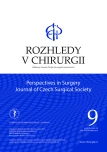Transplantace jater od dárců s nevratnou zástavou oběhu – první zkušenosti v České republice
Autoři:
J. Froněk 1,2,6; R. Novotný 1
; M. Kucera 1,6; J. Mendl 1; M. Kocík 1; P. Trunecka 3; P. Taimr 3; E. Kieslichová 4
; E. Pokorná 5; L. Janousek 1,6
Působiště autorů:
Transplant Surgery Department, Institute for Clinical and Experimental Medicine, Prague
1; Department of Anatomy, 2nd Faculty of Medicine, Charles University, Prague
2; Department of Hepatology, Institute for Clinical and Experimental Medicine, Prague
3; Department of Anesthesiology, Institute for Clinical and Experimental Medicine, Prague
4; Department of Organ Collection and Transplantation Databases, Institute for Clinical and Experimental Medicine, Prague
5; 1st Faculty of Medicine, Charles University, Prague
6
Vyšlo v časopise:
Rozhl. Chir., 2020, roč. 99, č. 9, s. 391-396.
Kategorie:
Original article
doi:
https://doi.org/10.33699/PIS.2020.99.9.391–396
Souhrn
Úvod: Transplantace jater je etablovanou život zachraňující metodou pro pacienty s akutním nebo chronickým jaterním selháním, některými vybranými malignitami jater. Vzhledem k nedostatku orgánů k transplantaci a současně narůstajícímu počtu pacientů na čekací listině, se dárci se smrtí oběhu (DCD) stávají stále důležitější možným zdrojem jaterních štěpů, s potenciálem částečně vyplnit mezeru mezi počtem dárců a příjemců.
Metody: Retrospektivní analýza DCD dárců a transplantací jater
Výsledky: V období květen 2016 až září 2019 jsme provedli v naší instituci celkem 9 transplantací jater od DCD dárců. Všechny výkony vyjma jednoho byly primotransplantace. Příjemci byli muži v 5 případech (56 %), ženy byly 4 (44 %). Průměrný věk DCD dárce byl 41±12 (22–57) let, doba strávená na umělé plicní ventilaci 7±1, teplá ischémie 19±3 minut. Průměrný věk příjemce byl 51±22 (4–73) let, doba studené ischémie 3h:59m±27m, manipulační čas 23±5 minut. Časně po transplantaci zemřel 1 pacient (11 %). V jednom případě jsme zaznamenali rekurenci hepatitidy C (11 %). Průběrná doba sledování je 19±13 (7–37) měsíců. Dosud jsme nezaznamenali ani jediný případ ischemické cholangiopatie.
Závěr: Transplantace jater od DCD dárců umožňuje navýšit počet jater k transplantaci od zemřelých dárců, současně tak pro pacienty snižuje dobu na čekací listině. Prezentovaný soubor dokumentuje první zkušenosti s touto metodou v České Republice.
Klíčová slova:
játra – transplantace – dárce se smrtí oběhu – první zkušenosti
Zdroje
1. Graziadei I, Zoller H, Fickert P, et al. Indications for liver transplantation in adults: Recommendations of the Austrian Society for Gastroenterology and Hepatology (ÖGGH) in cooperation with the Austrian Society for Transplantation, Transfusion and Genetics (ATX). Wien KlinWochenschr. 2016;128(19-20):679–690. doi:10.1007/s00508-016-1046-1.
2. Steinbrook R. Organ donation after cardiac death. N Engl J Med. 2007;357(3):209–213.
3. Rana A, Price MB, Barrett SC, et al. Aggressive utilization of liver allografts: Improved outcomes over time. Clin Transplant. 2020 [On line] doi: 10.1111/ctr.13860.
4. Reich DJ, Hong JC. Current status of donation after cardiac death liver transplantation. CurrOpin Organ Transplant. 2010;15(3):316–321. doi: 10.1097/MOT.0b013e32833991e3.
5. Sharma H, Tun Abraham M, Lozano P, et al. DCD liver transplant: a meta-review of the evidence and current optimization strategies. Curr Transpl Rep. 2018;153–165. https://doi.org/10.1007/s40472-018-0193-x.
6. Byass P. The global burden of liver disease: a challenge for methods and for public health. BMC Med. 2014;12 : 159. doi:10.1186/s12916-014-0159-5.
7. Taylor R, Allen E, Richards JA, et al. Survival advantage for patients acceptingthe offer of a circulatory death liver transplant. J Hepatol. 2019;70(5):855–865. doi: 10.1016/j.jhep.2018.12.033.
8. Strong R, Fawcett J. 20-year survival post-liver transplant: much more is needed! Hepatol Int. 2015;9(3):339–341. doi: 10.1007/s12072-015-9617-1.
9. Steinbrook R. Organ donation after cardiac death. N Engl J Med. 2007;357(3):209–213.
10. Biggins SW, Gralla J, Dodge JL, et al. Survival benefit of repeat liver transplantation in the United States: a serial MELD analysis by hepatitis C status and donor risk index. Am J Transplant. 2014;14(11):2588–2594. doi: 10.1111/ajt.12867.
11. Dubbeld J, Hoekstra H, Farid W, et al. Similar liver transplantation survival with selected cardiac death donors and brain death donors. Br J Surg. 2010;97(5):744–753. doi: 10.1002/bjs.7043.
12. Blasi A, Hessheimer AJ, Beltrán J, et al. Liver transplant from unexpected donation after circulatory determination of death donors: a challenge in perioperative management. Am J Transplant. 2016;16(6):1901–1908.
13. Jay C, Ladner D, Wang E, et al. A comprehensive risk assessment of mortality following donation after cardiac death liver transplant—an analysis of the national registry. J Hepatol. 2011;55(4):808–813.
14. Firl DJ, Hashimoto K, O’Rourke C, et al. Impact of donor age in liver transplantation from donation after circulatory death donors: a decade of experience at Cleveland Clinic. Liver Transpl. 2015;21(12):1494–1503.
15. Croome KP, Lee DD, Keaveny AP, et al. Improving national results in liver transplantation using grafts from donation after cardiac death donors. Transplantation 2016;100(12):2640–2647.
16. Tun Abraham M. Is there a learning curve in donation after cardiac death liver transplant: a Canadian single-centreexperience. In: Congress of the International Hepato-Pancreato-Biliary Association. 2016: Sao Paulo, Brazil.
17. Schlegel A, Muller X, Dutkowski P. Hypothermic liver perfusion. CurrOpin Organ Transplant. 2017;22(6):563–570. doi: 10.1097/MOT.0000000000000472.
18. Dutkowski P, Schlegel A, de Oliveira M, et al. HOPE for human liver grafts obtained from donors after cardiac death. J Hepatol. 2014;60(4):765–772. doi: 10.1016/j.jhep.2013.11.023.
19. Schlegel A, Muller X, Kalisvaart M, et al. Outcomes of DCD liver transplantation using organs treated by hypothermic oxygenated perfusion before implantation. J Hepatol. 2019;70(1):50–57. doi: 10.1016/j.jhep.2018.10.005.
20. Czigany Z, Lurje I, Schmelzle M, et al. Ischemia-reperfusion injury in marginal liver grafts and the role of hypothermic machine perfusion: molecular mechanisms and clinical implications. J. Clin. Med. 2020;9 : 846.
Štítky
Chirurgie všeobecná Ortopedie Urgentní medicínaČlánek vyšel v časopise
Rozhledy v chirurgii

2020 Číslo 9
- Metamizol jako analgetikum první volby: kdy, pro koho, jak a proč?
- Jak souvisí postcovidový syndrom s poškozením mozku?
- Stillova choroba: vzácné a závažné systémové onemocnění
- S MUDr. Petrou Vysočanovou o hypertenzi u diabetiků: Jak léčit skutečně účinně a bez zbytečných rizik?
Nejčtenější v tomto čísle
- Chirurgická léčba rozsáhlé perianální hidradenitidy
- Inkarcerovaná lumbálna hernia v oblasti trigonum Petiti ako príčina ileózneho stavu
- Změny normotermie během operačních výkonů
- Rozsáhlé poranění žlučových cest po laparoskopické cholecystektomii řešené tri-hepatikojejunoanastomózou na Y-Roux kličku: kazuistika

